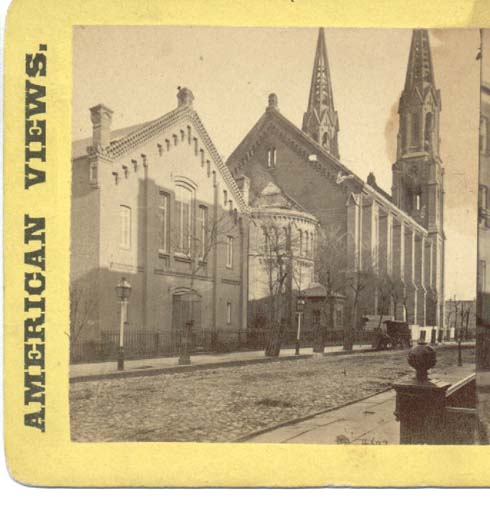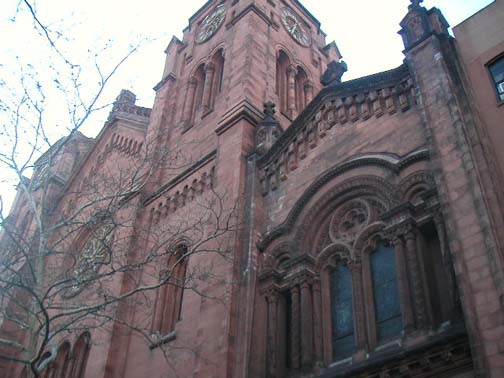|
New York Architecture Images-Gramercy Park St. George’s Church (Episcopal) |
|
|
architect |
exterior- Otto Blesch. interiors- Leopold Eiditz. |
|
location |
East 16th St. at Stuyvesant Square. (near 2nd Ave.) |
|
date |
1846-56 |
|
style |
Romanesque Revival, Rundbogenstil (German round-arched neo-Romanesque) |
|
construction |
The original gothic style stone spires were removed in 1889. |
|
type |
Church |
|
|
 |
| Special thanks to
Ginostuff for the image, and to Jazzage for identifying it and for supplying
the following info; Your stereopticon slide is of St. George’s Episcopal Church at East 16th St. and Rutherford Place in Manhattan. The view is from near Third Ave. looking to the northeast towards Stuyvesant Square (visible to the right of the tower). The view is particularly notable since it is shows the structure without its roof immediately after the 1865 fire. Also visible are both of the now-vanished spires (everything above the level of the clockfaces is now gone), and the original church hall --to the left of the semi-circular apse. This barn-like church hall (or chapel?) was demolished and replaced by a far grander rectory in the 1880’s (still standing, and now converted to condos, I believe). This is the church, by the way, where J. P. Morgan worshiped. Morgan was a lay officer of St. George’s and he also endowed and built the old NY Babies Hospital around the corner on the west side of Second Ave. between 17th & 18th Sts. just to the north of Stuyvesant Square (and still standing, though condos now also). The traditional rumor is that he built the hospital out of remorse for siring a child out of wedlock. From the St. George’s Episcopal Church website... http://stgeorgesnyc.dioceseny.org/index.html ...here is a photo of the NYC Landmarks Commission designation plaque which outlines the church’s history. Also from the St. George’s Episcopal Church website is a contemporary photo taken from nearly the same vantage point --except with a focal length much closer to the apse. It is instructive to compare details; evidently the apse was rebuilt with enlarged single windows in the triforium rather than the rhythmic groups of three it had originally. |
|
  |
|
 |
|
 |
|
|
images |
|
|
|
St. Georges Church (Episcopal), Rutherford Place & East 16th Street, New York, NY (1846-56) is one of the first and most significant examples of early Romanesque Revival in America. The exterior is thought to have been designed by the Bavarian born architect Otto Blesch. The interiors were designed by Leopold Eiditz. The original gothic style stone spires were removed in 1889. Acknowledgment: Andrew Dolkart, Guide to New York City Landmarks, 1991. |
|
notes |
J. P. Morgan was a warden and a faithful attendant. Harry Burleigh, a
soloist in the choir here for 52 years, helped win academic respect for
African-American music through his friendship with Antonin Dvorak. When St.
George's was built, in the forties, there was an unimpeded view from it to
the East River. Members of New York's `best families' began to settle in the
vicinity, and Stuyvesant Square, Rutherford Place, Irving Place, became
among the most desirable addresses in New York. By the last decade of the
nineteenth century they had been pressed out by the tide of German
immigrants coming northward on Second Avenue. But for a considerable period
after the fine old houses were abandoned by the very elegant, they were even
more notably occupied by a literary colony. And always, these forty years
past, Tammany chiefs have lived here, close — but not too close! — to the
`pee-pul.' Many doctors live there now, close to the hospitals.
It is, perhaps, the Quaker meeting-house, next to St. George's, which gives Stuyvesant Square an air that reminds some of old Philadelphia. There are many hospitals there, now; but the charm of yesteryears has not wholly departed. 205-207 East 16th: Formerly St George Memorial House; an 1886 gift from financier J.P. Morgan to the church. Now apartments. 209 East 16th: Pierce House; St George’s parish house, described by the AIA Guide as "a late medieval Germanic tower." HISTORY
During the 1840's, New York City was
expanding rapidly into the area north of 14th Street. The three
parishes commissioned three of the great architects of the day, Richard
Upjohn, James Renwick Jr., and Leopold Eidlitz to design The three congregations developed differing styles during the 19th century. They each sought, however, to balance a commitment to the Lord with a deep desire to serve humanity. Programs were developed, hospitals established, including St. Luke's, and efforts were made on a personal and corporate level to express the biblical and theological recognition of the deep worth of personhood. There was a real concern for justice and the pursuit of Truth, and aspects of life that are sometimes seen as mundane, as peripheral to the religious experience, were considered essential. Health and dental clinics, fresh-air camps, and the first trade schools in the city were operated by the Parish; soup kitchens were opened and fresh water was supplied for tenements before the city could provide it. In 1975, the three congregations merged to form one, and later the Church of the Holy Communion was sold to meet the needs of the economic crunch. In a sense our parish is very new. But having its roots in old New York, there is strength to be found in the knowledge that other generations of the Parish family, in times equally trying, have been faithful in their efforts to be the Church in New York City.
|
|
links |
http://stgeorgesnyc.dioceseny.org/index.html |